Exploring Kitchen Cabinets: A Comprehensive Guide
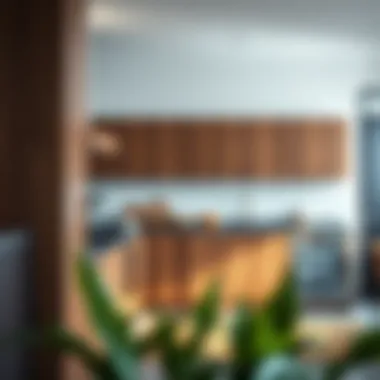
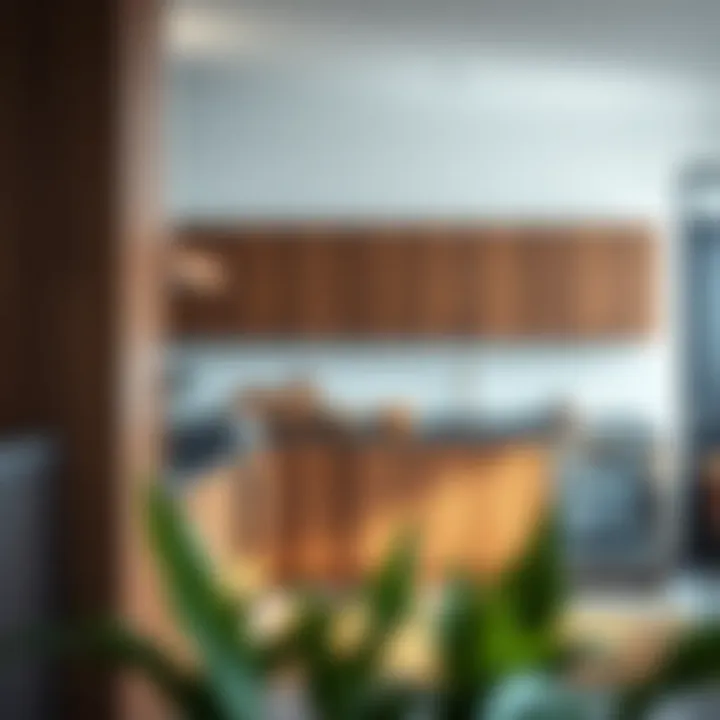
Intro
In the realm of modern interior design, kitchen cabinets serve a more significant purpose than merely holding utensils and dishes. They influence both the functionality and aesthetic of one of the most vital spaces in a home. This guide provides a thorough exploration of kitchen cabinetry, touching on everything from material choices and styles to practical considerations in selecting the right cabinets that resonate with the homeowner's vision.
As the heart of the home, the kitchen is where families gather, where meals are prepared, and often the focal point for social interactions. Hence, the importance of the cabinets cannot be understated. Whether you're a homeowner, a real estate investor, or someone interested in the latest market trends, understanding the current landscape of kitchen design is essential.
This guide will inform you about emerging trends within the kitchen cabinet market and provide insights into optimal storage solutions. It will also address maintenance and essential design elements tailored to modern sensibilities. Ready to dive into this comprehensive analysis? Let's unveil each layer of what makes kitchen cabinets a central piece in elevating your kitchen space.
Market Trends
Current Market Analysis
The kitchen cabinetry market is seeing exciting growth, particularly in urban areas like Dubai, where contemporary design trends are on the rise. With an increasing number of young families and professionals moving into the city, there's a growing demand for cabinets that marry style with storage solutions.
Many homeowners are now opting for materials like engineered wood or sustainable options such as bamboo. The trend is not just about looks; it extends to functionality as well. Soft-close hinges, pull-out shelves, and integrated lighting are just a few features gaining popularity. This shift also aligns with the increased focus on sustainability, which means more companies are offering eco-friendly cabinetry.
Future Projections
Looking ahead, the future of kitchen cabinets promises further innovation. Smart technology integration appears to be at the forefront, with features like voice-activated systems for opening cabinet doors and built-in refrigerator systems poised to redefine convenience in the kitchen.
Furthermore, style preferences may shift towards minimalism. Homeowners seem to appreciate clean lines and simple designs that exude elegance without excess clutter. As urban living spaces become tighter, multifunctional cabinets that can adapt to various kitchen layouts will likely take center stage.
"A well-designed space not only reflects current trends but also anticipates future needs."
Investment Strategies
Best Neighborhoods to Invest In
When it comes to investing in properties with appealing kitchens, some neighborhoods in Dubai stand out. Areas like Dubai Marina and Downtown Dubai feature homes with state-of-the-art kitchens equipped with modern cabinetry. These areas are attractive not just for their luxury but also for their proximity to amenities, making them hotspots for potential buyers.
The average price of a home in these regions tends to appreciate at a healthy rate. Given their combination of luxury and practicality, properties with upgraded cabinets can command higher resale values. Other neighborhoods, like Jumeirah Village Circle and Arabian Ranches, are also emerging quickly, presenting opportunities for savvy investors looking for properties with potential.
Tips for First-Time Investors
For those stepping into investment for the first time, focusing on kitchen details can make a meaningful difference. Here are some helpful pointers:
- Smart Features: Look for homes that incorporate modern technology in their cabinetry. Properties with adjustable shelving or built-in lighting can attract buyers.
- Quality Materials: Avoid properties with cheap materials. Investing in durable and stylish cabinets pays off.
- Style Versatility: Choose homes that have a neutral, timeless look. Buyers often gravitate towards designs that can fit various tastes and trends.
With these tips in hand, your entry into the real estate market can be smooth. Remember, the kitchen is where moments are made, so investing in quality cabinetry isn’t just a financial decision; it’s also about enriching lives.
Understanding the Importance of Kitchen Cabinets
Kitchen cabinets are often seen as the backbone of kitchen design, functioning not just as storage solutions but also as visual focal points in the space. In contemporary kitchens, cabinets do far more than merely hold pots and pans; they embody a harmonious blend of functionality and aesthetics, which is crucial for any modern living environment. Whether one is a homeowner looking to revamp a cooking space, a real estate agent guiding clients, or a developer aiming to maximize property appeal, understanding the significance of these fixtures is paramount.
Functionality and Aesthetics
The dual role of kitchen cabinets as both functional elements and aesthetic enhancements cannot be overstated. Functionality comes from maximizing space utilization, allowing residents to keep their kitchens organized and clutter-free. Think about the everyday hustle—having quick access to utensils, plates, or spices is invaluable. Well-designed cabinets can incorporate smart storage techniques.
Key Elements of Functionality:
- Easy Accessibility: Pull-out shelves or lazy Susans enable even the most awkward corners to be useful.
- Customized Layouts: Tailoring cabinet sizes and placements means catering to individual cooking habits.
- Durable Materials: Investing in robust materials ensures cabinets withstand the test of time, thus maintaining their utility.
On the aesthetic side, cabinets contribute significantly to the overall look and feel of a kitchen. They can set the tone—be it modern chic or classic rustic. The choice of materials, colors, and finishes allows homeowners to express their personal styles. High-quality finishes—glossy, matte, or textured—can elevate the entire ambiance.
Aesthetic Considerations:
- Color Schemes: Light colors may make a small kitchen feel larger, while darker shades can add warmth.
- Hardware Choices: Selecting the right knobs and handles can transform a simple cabinet into a statement piece.
- Design Styles: From minimalist frameless designs to traditional raised panel fronts, options abound to match any taste.
Impact on Home Value
Kitchen cabinets don't merely serve the current residents; they can substantially affect the property's resale value. A well-designed kitchen with modern cabinets can allure prospective buyers, who often view the kitchen as the heart of the home.
According to real estate trends, homes with updated kitchens—including cabinetry—tend to sell faster and at a higher price point compared to those with outdated or poorly designed styles. Investing in high-quality kitchen cabinets might seem like a luxury, yet it is a practical decision for those looking to boost their property’s worth. Real estate agents frequently emphasize the kitchen during showings, demonstrating that an aesthetically pleasing kitchen can be a persuasive selling point.
Factors Influencing Home Value:
- Current Market Trends: Preferences shift over time; keeping cabinets in line with popular styles can yield a better return.
- Quality versus Cost: While it is tempting to cut corners, low-quality cabinets may lead to disappointing results in terms of durability and appearance, thus impacting overall home valuation.
- Consistency with Home Design: Cabinets should complement the overall design of the house, ensuring cohesion throughout.
“It’s not about just filling space; it’s about creating a space that feels inviting and functional.”
In summary, kitchen cabinets represent more than mere storage in a home. They encapsulate a balance of usefulness and style, enhancing not only everyday experiences but also contributing to the property’s long-term value. Delving into the types and materials available for kitchen cabinets can help refine choices that meet individual needs while elevating home aesthetics.
Types of Kitchen Cabinets
When diving into the realm of kitchen design, understanding the types of kitchen cabinets is crucial. These cabinets are not just storage spaces; they define the kitchen's look and function. Whether you're overseeing a renovation or just pondering upgrades, grasping the variety of cabinets available can significantly influence your decisions. Each type has its unique qualities, benefits, and ideal applications, facilitating both aesthetic appeal and practical utility.
Base Cabinets
Base cabinets sit at the heart of any kitchen, as they provide essential support for counters, appliances, and fixtures. Typically, these cabinets measure around 34 to 36 inches in height, making them compatible with standard countertop heights. Not only do they house kitchen essentials like pots and pans, but they also establish the layout of the kitchen.
Consider the following:
- Support: Base cabinets support countertops, which are vital for meal prep and other tasks.
- Versatility: They can come with various configurations, from drawers to shelving, catering to diverse storage needs.
“Base cabinets are often the backbone of kitchen efficiency, providing both strength and adaptability.”
Wall Cabinets
Positioned high on the walls, wall cabinets serve to maximize space without cluttering the floor area. Generally, they are more shallow than base cabinets, allowing them to hold dishes, spices, and other items without overreaching. Their height can make them tricky to access for short individuals, but they store a multitude of essentials at a convenient level.
Key considerations include:
- Space Optimization: Perfect for small kitchens that need to utilize available wall space.
- Aesthetic Appeal: They can enhance the kitchen’s visual aspect if designed and painted well.
- Accessibility: Including pull-down racks or open shelving options can improve function.
Tall Cabinets
Tall cabinets, often referred to as pantry cabinets, are ideal for storing food items and larger kitchen appliances. These cabinets can extend from the floor to the ceiling, offering maximum vertical storage space. Their construction is particularly beneficial in maximizing storage in kitchens with limited square footage.
- Efficient Storage: They allow for the organization of everything from canned goods to small kitchen gadgets.
- Cohesion in Design: When considered alongside base and wall cabinets, they can create a unified look throughout the kitchen.
Specialty Cabinets
Lastly, specialty cabinets cater to specific needs. These could range from wine racks and pull-out spice drawers to appliance garages designed to tuck away the likes of blenders and toasters. Specialty cabinets can also encompass corner cabinets that have unique designs, such as lazy Susans, which are perfect for optimizing hard-to-reach areas.
Things to note include:
- Customization: Tailoring specialty cabinets to your kitchen’s layout can significantly enhance functionality.
- Creative Design: They offer opportunities for design flair, making your kitchen not just practical but also personalized.
Material Choices for Kitchen Cabinets
The choice of materials for kitchen cabinets is a fundamental aspect that influences both aesthetics and longevity. In a world where homeowners seek not just beauty but functionality, understanding various materials becomes crucial. The ideal materials can enhance a kitchen's appearance while ensuring the cabinets endure daily wear and tear. Selecting the right material is essential; it speaks to both the cost-effectiveness and the kitchen's ultimate ambience.
Wood Varieties
Wood stands out as a classic choice for kitchen cabinets, adored for its warmth and timeless appeal. There is a variety of wood types available, each with unique characteristics, allowing homeowners to tailor the look and feel of their kitchens.
- Oak: Known for its durability and strong grain, oak is a popular option. It resists scratching and denting, making it suitable for high-use kitchens.
- Maple: Often chosen for its smooth surface and subtle appearance, maple is versatile and can be stained in various shades. This makes it a great choice for modern designs.
- Cherry: Over time, cherry wood develops a rich patina, adding depth to darker kitchen designs. Its natural reddish hue also brings warmth.
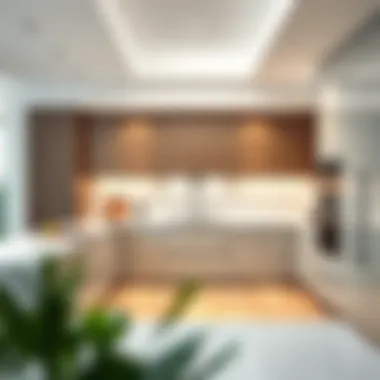
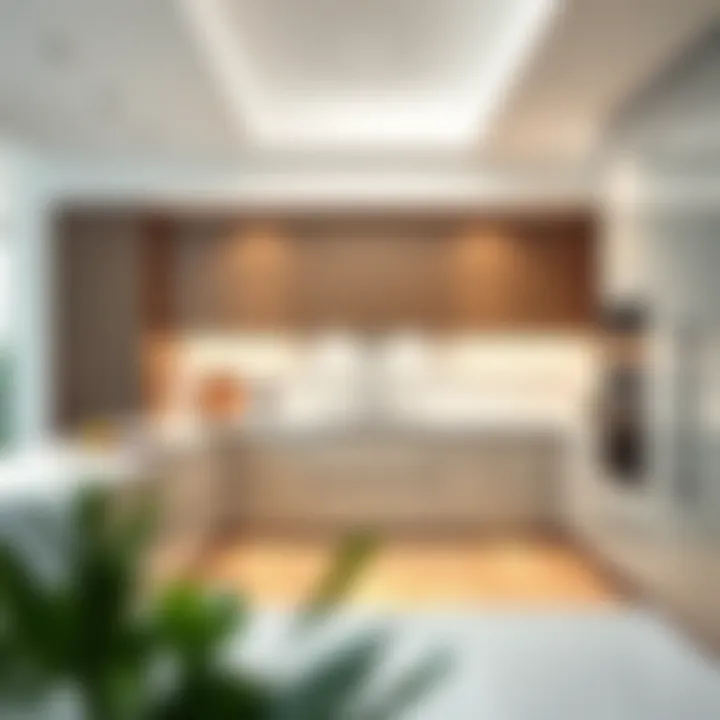
Homeowners must also consider the sustainability of wood sourcing. Opting for reclaimed or sustainably harvested wood can not only reduce environmental impact but also add a unique story to your kitchen.
Metal and Glass Options
Incorporating metal and glass in kitchen cabinets brings a modern twist to traditional designs. Metal cabinets offer durability and a sleek finish, fitting perfectly in contemporary settings. Stainless steel is particularly praised for its resistance to rust and corrosion, appealing to both hygiene and maintenance concerns.
Glass-front cabinets are favored for their ability to create a sense of openness and space. They allow homeowners to display beautiful dishware or glassware, adding a personalized touch to the kitchen. Furthermore, frosted or textured glass can provide a level of modesty while still showcasing cabinet contents.
Nevertheless, the choice of metal or glass requires careful consideration. Fingerprints and smudges can be visible on stainless steel, meaning regular cleaning is a must. Meanwhile, glass can be prone to breaking, thus requiring installation skill and precision to ensure safety and stability.
Laminate and MDF
Laminate and Medium-Density Fibreboard (MDF) provide cost-effective alternatives to solid wood, while still offering quality and versatility. Laminate surfaces are known for their wide range of colors and designs. They can mimic the appearance of more expensive materials while being less sensitive to moisture, making them suitable for kitchens.
MDF, on the other hand, is an engineered product that is denser and generally more affordable than solid wood. It is less likely to warp over time compared to traditional wood, making it a smart choice in humid or wet environments.
However, both laminate and MDF can present challenges in terms of durability. While they are resistant to some types of damage, they are not as long-lasting as solid woods or metals. Therefore, it��’s essential to weigh the pros and cons against your kitchen usage and personal style preferences.
"The materials chosen for kitchen cabinets not only define the initial look but also dictate the lifespan and maintenance expected in the long run."
Understanding the diverse range of materials available for kitchen cabinets empowers homeowners and investors alike. The right selection can transform a kitchen from a functional area into a stunning focal point that complements the entire home.
Styles and Designs
Styles and designs play a critical role in how kitchen cabinets impact both functionality and the overall aesthetic of a space. Homeowners and investors alike should appreciate that the choice of style isn't just about personal preference; it's also about enhancing the value and appeal of the kitchen. From contemporary chic to timeless traditions, styles define the kitchen's character. It's essential to consider how these designs will align with both current trends and long-term durability. Each style carries its benefits and challenges, influencing factors from resale potential to harmony with existing decor.
Contemporary Designs
Contemporary designs are all about minimalism and clean lines. Think sleek surfaces, open spaces, and a focus on functionality without unnecessary ornamentation. Cabinets in this style often feature high-gloss finishes, flat-panel doors, and innovative hardware that enhances usability.
The beauty of contemporary designs lies in their adaptability. They can seamlessly blend with other design elements, such as modern appliances and lighting fixtures. Homeowners leaning towards this style can expect to create spaces that look refined yet inviting.
Some characteristics of contemporary cabinets include:
- Neutral or bold color palettes: Whites, grays, or the occasional pop of color add visual intrigue.
- Use of innovative materials: Glass, metal, or engineered wood can create a unique look.
- Integration of technology: Consider options like smart features that elevate both utility and style.
Homeowners should also keep in mind the practicality of contemporary designs, as they tend to offer more organized storage solutions, fitting perfectly into the lifestyle of busy individuals.
Traditional Styles
Traditional styles resonate with warmth and charm, frequently incorporating classic wood species like oak or maple. These designs may feature raised-panel doors, intricate moldings, and rich finishes that exude elegance.
It's a versatile style that can cater to varying tastes—whether you're aiming for a cozy farmhouse feel or a more sophisticated, formal dining ambiance, traditional cabinets can meet the mark. Their ornate detailing not only showcases craftsmanship but also enhances the value of your space.
Key aspects of traditional cabinet styles include:
- Warm color tones: Rich browns, creams, and muted greens.
- Classic hardware: Think antique brass or traditional handles that complete the look.
- Customization options: Traditional cabinetry allows for personalization options, such as intricate carvings or specific color stains.
While traditional cabinets may require additional maintenance due to their finishes and decorative features, their timeless appeal often outweighs these considerations for many homeowners.
Rustic Influences
Rustic influences evoke a sense of the natural world, emphasizing organic elements. This style often incorporates reclaimed wood, distressed finishes, and natural textures, all of which contribute to a warm and inviting atmosphere. Rustic cabinetry can transform a kitchen into a cozy retreat, making it ideal for those wanting to create a more down-to-earth feel.
The characteristics that define rustic kitchen cabinets include:
- Natural finishes: Unfinished or lightly stained woods ensure the material's inherent beauty shines through.
- Textured surfaces: Rough, hand-hewn designs can add depth and character.
- Sustainable materials: Often, rustic styles use reclaimed wood, appealing to environmentally conscious homeowners.
Rustic designs do require considerations regarding durability and maintenance, but they often stand the test of time, both in style and wear. Their charm lies in their imperfections, contributing to a dialogue about sustainability and authenticity.
Incorporating any style into kitchen cabinetry requires careful thought, but aligning the choice with personal values and lifestyle needs is crucial. The right cabinets can not only enhance a kitchen but can serve as a statement in the home, reflecting the tastes and priorities of the homeowner.
Color and Finish Options
Color and finish options play a pivotal role in transforming kitchen cabinets from mere storage units to central design elements in any culinary space. They influence not only the aesthetic appeal but also the perceived size and atmosphere of the kitchen. With so many choices available in today’s market, it's crucial for homeowners and investors alike to understand how these elements can significantly impact the overall look and feel of their kitchens.
A well-chosen color palette can make a kitchen feel more expansive, inviting, or modern. The finish on cabinets adds another layer of texture and depth, enhancing the visual interest of the kitchen. From high-gloss to matte, each finish has its own charm, keeping the space lively and dynamic. When deciding on colors and finishes, one must consider factors such as existing decor, lighting, personal style, and even the local market trends in real estate, especially in a diverse market like Dubai's.
Popular Color Schemes
When it comes to color schemes for kitchen cabinets, a few trends consistently stand out. Here’s a look at some popular choices:
- Classic White: Timeless and versatile, white cabinets are a staple in many homes, providing a clean backdrop and allowing flexibility with decor.
- Rich Neutrals: Shades like taupe, beige, and grey are increasingly popular, adding warmth and elegance while remaining subdued enough to blend with various design styles.
- Bold Colors: For the adventurous, deep blues, greens, and even blacks can create a striking focal point, especially when paired with contrasting countertops.
- Pastels: Soft colors like mint or blush are making a comeback, giving a fresh, airy feel to kitchens.
"Choosing the right color scheme can set the mood of the entire kitchen—make it your canvas!"
Finishing Techniques
The finish applied to kitchen cabinets can alter their appearance and functionality in surprising ways. Here are some notable finishing techniques:
- High-Gloss Finish: This technique offers a shiny look, reflecting light and enhancing the perception of space. However, it may require more frequent cleaning, as it shows fingerprints and smudges easily.
- Matte Finish: Matte finishes tend to create a softer appearance, with less glare. They can create a more rustic or modern feel, depending on the color chosen.
- Glazed Finish: A popular choice for traditional kitchen designs, glazing adds depth to wood grain and enhances the overall richness of the cabinetry. This technique typically suits intricate designs best.
- Stained Finish: Staining showcases the natural beauty of the wood while allowing for a variety of hues, from light to dark. This can be especially beautiful in custom-made cabinets where the natural wood grain adds character.
- Distressed Finish: Providing a vintage or rustic charm, distressed finishes give cabinets an antiqued look that appeals to those who appreciate character and history.
In summary, understanding color and finish options not only enhances the beauty of kitchen cabinets but also contributes to the overall design narrative. For anyone looking to remodel or invest in kitchens, keeping these considerations in mind is essential to create spaces that are both functional and aesthetically pleasing.
Storage Solutions in Kitchen Cabinets
Storage solutions play a pivotal role in the functionality of kitchen cabinets, transforming a standard kitchen space into an organized and efficient culinary hub. In an environment where every inch counts, an effective storage strategy can elevate the utility of cabinets and enhance the overall aesthetic of the room. Homeowners, developers, and market analysts alike recognize the importance of optimized storage solutions, as they often influence both the practical use of the kitchen and its appeal to potential buyers.
The foremost benefit of efficient storage solutions lies in maximizing space. No one wants a cluttered kitchen, where items are strewn about, making it hard to find what you need, when you need it. Therefore, understanding various strategies for organization can help to avoid creating a frustration-filled cooking zone.
Maximizing Vertical Space
Vertical space is a goldmine often underutilized in kitchen designs. Many homeowners focus on the horizontal expanse, but considering the height of cabinets can provide essential storage opportunities. Installing cabinets that reach the ceiling can help eliminate dead space while also creating an illusion of height and grandeur. Additionally, using shelves and hooks can facilitate easy access to frequently used items without adding clutter to the countertops.
Considerations for vertical storage include:
- Shelf Dividers: These can help to keep different items segregated and easily accessible.
- Tall Cabinets: Incorporating tall cabinets allows the storage of larger items like bakeware or kitchen appliances.
- Hanging Solutions: Pot racks or magnet strips for knives can free up counter space and create an organized look.
Pull-Out and Slide-Out Features
Pull-out and slide-out features are game changers for anyone wanting a user-friendly kitchen. These innovations offer a means of accessing deep cabinet spaces that can otherwise be difficult to navigate. Instead of digging into the depths of a traditional pantry or base cabinet, these features allow homeowners to simply slide out what they need, minimizing the hassle and maximizing convenience.
Key advantages of pull-out and slide-out features are:
- Accessibility: Easily reach back corners that usually get ignored.
- Visibility: Everything is laid out in view making it easier to locate items quickly.
- Space Efficiency: They can condense items into organized compartments, thus allowing for more room to store essentials.
Efficient storage solutions not only optimize space but can also significantly enhance the kitchen’s visual appeal, making it a more inviting space.
Installation Considerations
The installation of kitchen cabinets is a pivotal step that can significantly influence the overall outcome of a renovation project. The right installation approach can enhance not just the functionality of the cabinets but also their aesthetic appeal, contributing to the kitchen's overall harmony. Whether one chooses to hire a professional or opt for a DIY approach, understanding the nuances of cabinet installation is essential. By considering various elements, one can ensure long-lasting performance and satisfaction with the installed cabinetry.
Professional vs. DIY Installation
When weighing the decision between professional installation and a do-it-yourself approach, several factors come into play.
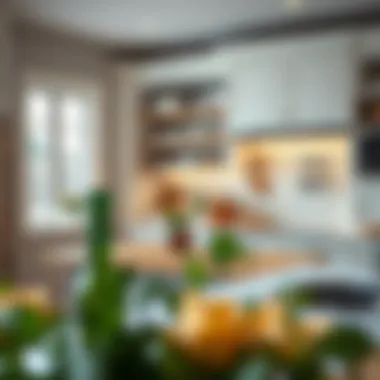
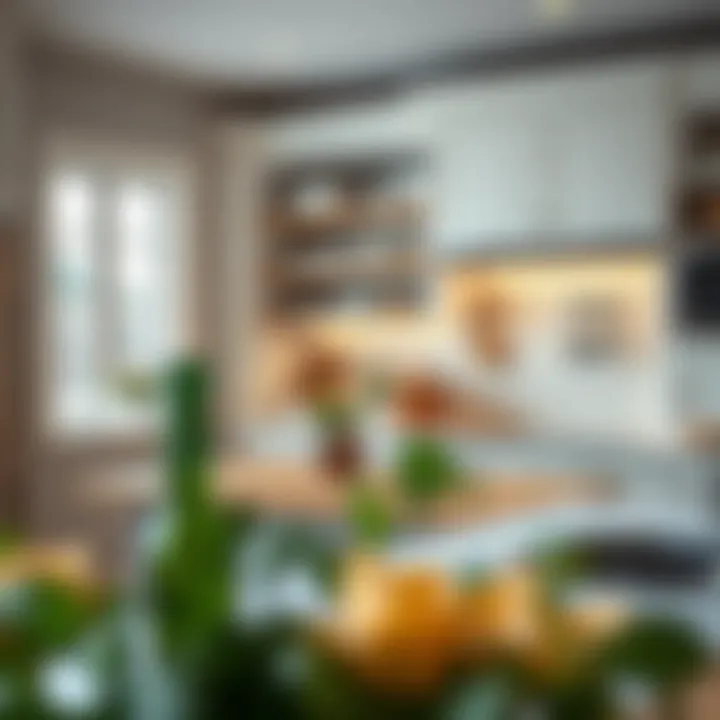
- Expertise and Experience: Professionals possess the know-how to deal with intricate details. They are familiar with various cabinetry systems and can troubleshoot potential issues efficiently. For instance, experienced installers know how to level cabinets properly, which is crucial for maintaining alignment and functionality.
- Time Commitment: Installing cabinets is no small feat. For homeowners with a busy schedule, hiring a professional can save precious time. Think about it: while weekend warriors might be physically able, the hours dedicated to first-time installations could extend far longer than anticipated.
- Cost Implications: While DIY might appear more economical, the potential for pitfalls exists. Mismeasuring, improper alignment, or inadequate securing can lead to costly fixes down the line. Therefore, a professional’s fee might be justified when they save you from future headaches.
In contrast, a DIY enthusiast can take pride in personal involvement. It fosters a personal touch and a sense of ownership over the project. However, meticulous planning and a solid understanding of carpentry are essential to avoid damaging materials.
Common Installation Challenges
During cabinet installation, one may encounter challenges that require swift resolution. A few common concerns include:
- Measurement Issues: One of the most common pitfalls arises from incorrect measurements. Failing to measure twice can lead to ill-fitting cabinets, which may necessitate adjustments or replacements.
- Leveling Problems: Properly leveling cabinets is critical. Uneven cabinetry not only looks unsightly but can also compromise functionality, such as door alignment.
- Wall Irregularities: Walls in older homes might not be perfectly straight. Dealing with warped walls can complicate the installation process. Techniques such as shimming can help rectify this, but it may require a bit of extra skill or experience.
"It is crucial to ensure that the base cabinets are securely anchored to the wall to avoid any unwanted shifting or issues over time."
- Hardware Installation: Failing to understand the required hardware for cabinet doors and drawers can lead to installation headaches. Misalignment can affect usability and longevity, so correct hardware placement is paramount.
Tackling these challenges head-on and preparing adequately can lead to a much smoother installation process. Being aware of potential issues in advance can make the difference between a satisfying outcome and a frustrating experience.
Maintenance and Care for Kitchen Cabinets
Keeping your kitchen cabinets in tip-top shape isn't just about aesthetics; it's a vital part of maintaining the overall integrity and functionality of your kitchen. Proper maintenance ensures that your cabinets withstand the test of time, enhancing their durability and keeping your kitchen looking fresh. Over the years, cabinets can sustain damage from spills, wear, and dust accumulation, making it important to adopt best practices for care.
Why is Maintenance Important?
Neglecting regular care can lead to serious issues like warped doors, damaged finishes, or even pest infestations. By spending a little time each month on upkeep, you can avoid these headaches down the line. Not only does it help in preserving physical condition, but it can also maintain the value of your home. If you ever decide to sell, a well-maintained kitchen is likely to attract buyers.
"Taking care of your kitchen cabinets is like tending to a garden. Regular attention yields a healthier environment in your kitchen."
Cleaning Techniques
Effective cleaning is the backbone of cabinet care. Understanding the right techniques and products to use can make all the difference. Here's how to go about it:
- Mild Soap and Water:
Start with the simplest solution. A mixture of warm water and a few drops of mild dish soap provides an effective cleaning solution. Use a soft cloth to gently wipe down surfaces. - Avoid Harsh Chemicals:
Strong cleaners can damage finishes and warp materials. Harsh abrasive scrubs should also be off the table. Instead, consider edge cases where specialized products are needed, such as for removing greasy build-up. - Spot Testing:
Always spot-test any cleaner in an inconspicuous area to ensure it doesn't damage the finish or color. - Routine Wipe Down:
Aim for a quick wipe-down every day, especially after cooking, to prevent food residue from hardening. - Deep Cleaning:
Schedule a deeper clean every few months—taking the time to focus on corners, handles, and areas often missed in daily cleaning routines.
Preventative Measures
Taking a forward-thinking approach can be a game changer. Rather than waiting for potential disasters, employ preventative measures to preserve your cabinets' lifespan:
- Use Coasters and Placemats:
Whenever you place items like pots, pans, or delicates on cabinet surfaces, always use coasters or mats to prevent scratches and moisture damage. - Humidity Control:
Excess moisture can lead to warped wood cabinets, especially in humid climates like parts of Dubai. Limit exposure by using exhaust fans while cooking or investing in a dehumidifier if necessary. - Regular Inspection:
Every couple of months, take a stroll around your kitchen and inspect your cabinets. Look for any signs of wear, such as chipped paint or loosening hinges, and address them promptly. - Keep Away Heat Sources:
Position cabinets away from direct heat sources like stoves or ovens, as constant exposure can fade and dry out the finishes. - Consider Protective Coatings:
For wood cabinets, applying a quality sealant can bolster their resilience against spills and stains.
By implementing these cleaning techniques and preventative measures, not only will your kitchen cabinets remain visually appealing, but they will stand tall against the test of time. Investing a little time today can save significant costs and headaches in the future.
Trends in Kitchen Cabinet Design
The landscape of kitchen cabinet design is constantly evolving, reflecting broader trends in interior design, sustainability, and technology. Understanding the current trends is essential not only for homeowners looking to update their kitchens but also for investors and real estate agents contemplating market preferences. The impact of a well-thought-out cabinet design goes beyond mere aesthetics; it influences functionality, storage efficiency, and even the resale value of a property.
Sustainability in Materials
In recent years, there has been a significant shift towards sustainability in kitchen cabinet materials. With the growing emphasis on environmental consciousness, many homeowners are prioritizing eco-friendly options over traditional materials.
- Reclaimed Wood: Cabinets made from reclaimed wood not only showcase unique textures and colors but also reduce the demand for new lumber, making them a greener choice. The charm of reclaimed wood can add character to any kitchen space while minimizing environmental impact.
- Bamboo: As a rapidly renewable resource, bamboo presents an attractive alternative. Its durability and unique look make it a sought-after material for modern designs.
- Low-VOC Finishes: Volatile organic compounds (VOCs) found in many finishes can adversely affect indoor air quality. Choosing low-VOC or water-based finishes helps to create a healthier environment.
Investing in sustainable materials not only aligns with a growing trend but can also increase a home's appeal to environmentally conscious buyers in Dubai's competitive real estate market.
Smart Storage Solutions
Efficiency is key in kitchen design, and smart storage solutions are becoming increasingly important. These clever features not only maximize space but also enhance functionality, catering to the needs of modern homeowners.
- Pull-Out Shelves: These shelves bring kitchen essentials within easy reach, eliminating the need to dig through deep cabinets.
- Lazy Susans: Ideal for corner cabinets, lazy Susans maximize use of difficult spaces, providing easy access to items without the hassle.
- Drawer Dividers: Customizable dividers help keep utensils organized, making meal prep a more seamless experience.
Incorporating these smart storage solutions into kitchen design not only maximizes space effectively but also has the potential to attract buyers willing to invest in properties that cater to modern needs.
"The kitchen is the heart of the home; the right cabinets can make it a heartbeat of efficiency and style."
By embracing these trends in kitchen cabinet design, homeowners and real estate professionals alike can ensure they are at the forefront of the market, making informed decisions that resonate with contemporary values and preferences.
For more information about sustainable practices, you can check out resources from Wikipedia and Britannica.
Budgeting for Kitchen Cabinets
When embarking on a kitchen renovation, budgeting for cabinets becomes a pivotal consideration. The right cabinets not only influence the kitchen's utility but also its aesthetic appeal. Investing in quality cabinetry can yield a significant return, especially in real estate where kitchens often sway buyers' decisions.
Cost Considerations
Most kitchen cabinets do not come cheap, but understanding the nuances of pricing can aid in making informed choices. Prices vary widely based on materials, styles, and customization options. Here are some key elements to keep in mind:
- Material Costs: Solid wood cabinets typically come at a premium compared to laminate or MDF options. For instance, oak and maple are favorites for their durability and appearance, yet they might stretch your budget.
- Craftsmanship and Customization: Custom cabinets crafted by local artisans can add flair but also carry a hefty price tag. Conversely, prefabricated cabinets offer a wallet-friendly option, albeit with limited choices for customization.
- Finishes and Hardware: Don’t overlook the impact of finish and hardware on the total cost. Elegant knobs and sleek finishes can elevate cheaper materials into something that feels more upscale.
With these factors, it’s wise to set a realistic budget that allows room for both practicality and personal taste. Ensuring you factor in installation costs is also vital; sometimes, the DIY route may save a few bucks, but it’s critical to evaluate your skills honestly.
Financing Options
Navigating the costs of kitchen cabinets can seem daunting, particularly if your budget is tight. Fortunately, there are various financing options available to help ease the financial strain. Some possible avenues include:
- Home Improvement Loans: These are specifically designed for renovations and can cover a significant portion of your cabinet costs. They often come with lower interest rates than personal loans.
- Credit Cards: If you're disciplined with payments, using a credit card for smaller purchases could be beneficial. Some cards offer cashback rewards or extended warranties on items purchased.
- Retail Financing Programs: Many stores provide financing options for their cabinets, sometimes with zero-interest promotional periods. Just be cautious about the terms to avoid hidden fees in the long run.
"Budgeting is not about limiting yourself; rather, it’s about making room for your priorities."
Custom vs. Prefabricated Cabinets
When it comes to kitchen design, the choice between custom and prefabricated cabinets stands out as a crucial decision. Each option carries its own distinct advantages and considerations, making them appealing to different kinds of homeowners, real estate investors, and developers. Understanding these differences is vital for anyone looking to create a space that marries function with aesthetics while staying on budget.
Advantages of Custom Cabinets
Custom cabinets are often seen as the gold standard due to their blend of craftsmanship and personalization. Here’s why they might be your best bet:
- Tailored Fit: Custom cabinets are designed to fit your kitchen's unique layout, ensuring no awkward gaps or ill-fitting elements. This can make a tiny space appear larger and more efficient.
- Material Choices: You have the freedom to choose every aspect, from the type of wood to the finish and hardware. Whether you’re eyeing oak for its durability or cherry for its beautiful hue, the choice is yours.
- Maximized Functionality: Custom options allow you to incorporate features tailored to your habits, such as pull-out spice racks or deep drawers for pots and pans.
- Style Integration: They can be designed to match specific aesthetics, whether it’s a sleek modern look or a quaint rustic charm, ensuring that they harmonize with your overall decor.
- Increase Home Value: A well-designed custom kitchen can significantly elevate property value, appealing to buyers who appreciate quality craftsmanship and a unique design.
"Custom cabinetry not only complements your kitchen's architecture but can be a long-term investment in your property’s value."
Benefits of Prefabricated Solutions
On the other hand, prefabricated cabinets, often considered the more budget-friendly choice, have their own set of appealing characteristics:
- Cost Efficiency: Prefabricated cabinets typically cost less than their custom counterparts. They provide a solid option for those working on a tighter budget.
- Quicker Availability: Since these cabinets are mass-produced, they often come with shorter lead times, which can be crucial for those on a renovation timeline.
- Wide Variety: Available in various styles and finishes, you can find something that aligns with your vision without the hassle of bespoke design processes.
- Less Installation Complexity: Many prefabricated cabinets are designed for easier installation, which can save on labor costs or make DIY endeavors more feasible.
- Consistent Quality: Manufacturing processes ensure that each piece is produced under quality controls, reducing the variability commonly found in hand-crafted items.
For further insights into cabinet design trends and options, you can refer to resources like Wikipedia or Britannica to deepen your understanding of the subject.
The Role of Cabinet Hardware
When it comes to kitchen cabinets, hardware might seem like the cherry on top. However, it plays a pivotal role in the overall functionality and aesthetic of your cabinets. Think of cabinet hardware as the jewelry of the cabinetry world; it can either make or break the look and usability of your kitchen. With an array of choices out there, understanding the significance of selecting the right hardware is essential for every kitchen design, especially in the context of rising trends in Dubai's real estate market.
Cabinet hardware encompasses knobs, pulls, hinges, and slides that allow you to open and close cabinets smoothly. They are crucial not just for functionality but also for setting the stylistic tone of the entire kitchen. Quality hardware can enhance the durability of cabinets, ensuring they withstand the daily wear and tear that kitchens experience.
"In the realm of kitchen design, it's often the smallest details that have the greatest impact."
Moreover, investing in the right hardware can elevate the perceived value of your kitchen, offering an attractive return on investment for homeowners and real estate investors alike. If you’re prepping for a sale or simply want to boost your home's appeal, modernizing your cabinet hardware can go a long way.
Selecting Functional Hardware
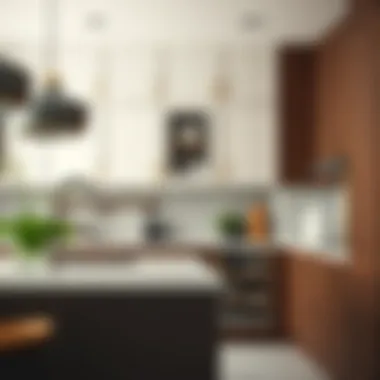
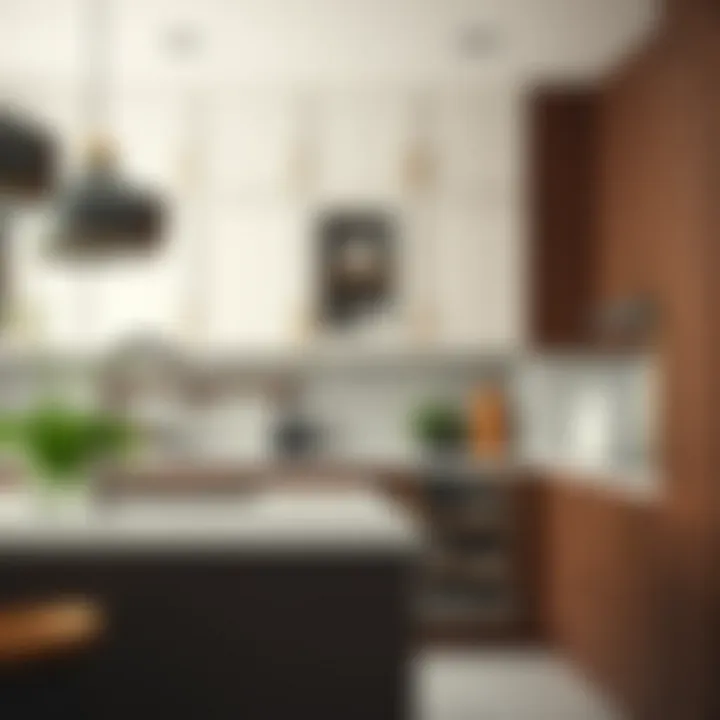
Choosing functional hardware involves considering practicality alongside style. For instance, if you’re someone who often cooks and has to navigate a busy kitchen, opting for pulls over knobs might be beneficial. Pulls are generally easier to grasp, especially when your hands are full or greasy. Additionally, you should think about the size of your hardware—the bigger the pull, the easier it will be to grab, especially on larger kitchen cabinets.
When selecting hinges and slides, check for soft-close options that prevent slamming. The quiet motion of soft-close features can enhance your kitchen's tranquil vibe, making it a more pleasant gathering place.
In this digital age, it’s also worth looking at hardware that offers integrated technology, such as smart locks or sensors that allow for touchless opening. This not only embodies convenience but can also be an attractive feature for tech-savvy buyers.
Aesthetic Considerations
Aesthetics should never be an afterthought in your kitchen design. The hardware you choose should not only be functional but also complement your overall kitchen style. If you have a modern kitchen, sleek stainless steel pulls can enhance a contemporary vibe; meanwhile, ornate bronze knobs might lend a more traditional feel.
Think about the following elements when choosing your hardware:
- Color and Finish: Decide whether you want a matte finish or something shiny. Matte finishes can provide a sophisticated touch, while polished finishes might add brightness.
- Style and Shape: Round knobs offer an easy grip, but angular pulls can create visual interest.
- Proportion: Hardware should be proportional to the size of the cabinet. Oversized knobs on small drawers can look awkward.
Lastly, don't shy away from mixing hardware styles. A blend of different finishes can create a dynamic environment. Just ensure that the overall result looks cohesive—like the pieces of a well-composed orchestra.
In summary, the right cabinet hardware can significantly affect both functionality and appearance in kitchen design. For homeowners, developers, and investors alike, paying close attention to these details can ensure that every cabinet becomes not just a utilitarian space but also a striking feature of the kitchen.
Cabinet Lighting Options
Lighting in kitchen cabinets might not get the spotlight it deserves, but its role in both functionality and style is monumental. Good lighting transforms a kitchen from mere utility to a vibrant living space. As kitchens increasingly become the heart of the home, the blend of ambient and task lighting can elevate not just the aesthetic but also the day-to-day experience.
Ambient vs. Task Lighting
When it comes to kitchen lighting, understanding the distinction between ambient and task lighting is crucial.
- Ambient lighting serves as your kitchen's backdrop lighting, creating a welcoming atmosphere. This is the light that fills the space and sets the mood. Think of it as the soft glow of overhead fixtures or wall sconces softly illuminating your lovely cabinetry.
- Task lighting, on the other hand, is focused and bright, designed specifically to aid in activities like cooking, chopping, or cleaning. Under-cabinet lights are perfect for this, ensuring that your countertop workspace is well-lit and shadows are kept at bay.
Imagine preparing a meal without glaring into dark corners or tripping over something unseen—task lighting makes all that possible.
When blending the two, consider placing recessed lights in the ceiling for ambient light while installing LED strip lights under your cabinets for that sharp beam of task light.
"Lighting can profoundly enhance or diminish the practicality and appearance of your kitchen space. Choose wisely, and it’s like striking gold!"
LED and Energy-Efficient Solutions
Switching to LED lighting is a game-changer in the kitchen cabinet lighting arena. Not only do LEDs last longer than traditional bulbs, but they’re also incredibly energy efficient. This invites a dual bonus: saving on those energy bills and reducing the trips to the store for replacement bulbs. Here are some of the reasons you might consider LEDs:
- Longevity: LEDs can last up to 25,000 hours, which means fewer replacements.
- Energy Savings: They use about 75% less energy than incandescent bulbs.
- Variety: Available in an array of colors and brightness levels, they can match any décor—from warm and cozy to cool and modern.
- Heat Reduction: Unlike incandescent bulbs, LEDs don't throw off a ton of heat, which can be a blessing in the kitchen where radiated heat can make cooking uncomfortable.
For those keen on sustainability, exploring solar-powered LED options may also open up new avenues of eco-friendly lighting.
In summary, the lighting you choose for your kitchen cabinets plays a vital role in functionality, safety, and aesthetics. By combining ambient and task lighting with modern solutions like LEDs, you can create a kitchen that is not only visually appealing but also practical for everyday tasks.
Incorporating Modern Technologies
As kitchens evolve into multifunctional hubs within our homes, the inclusion of modern technology in cabinet design becomes not just a trend, but a necessity. The integration of cutting-edge elements in cabinetry can significantly enhance both usability and aesthetic appeal, allowing homeowners and investors to maximize their kitchen's potential. This section delves into how modern technologies, specifically smart cabinets and appliance integration, reshape kitchen landscapes and elevate user experience.
Smart Cabinets and IoT
In today's tech-savvy world, the Internet of Things (IoT) has seeped into every corner of our lives, and the kitchen is no exception. Smart cabinets, equipped with advanced features, are changing the way we interact with our cooking spaces. These cabinets often come with built-in sensors that can notify users when supplies are running low. For instance, if you have a smart pantry cabinet, it might alert you when you’re down to the last few jars of spices or when a staple like flour is near depletion. This kind of intelligence not only helps in timely restocking but also mitigates food wastage.
"Smart cabinetry can reshape kitchen management, providing users with insights into inventory and even meal suggestions based on available ingredients."
Moreover, smart storage solutions may include custom lighting that adjusts based on the time of day, creating an inviting atmosphere in the kitchen while also improving visibility for better searching.
Advantages of Smart Cabinets
- Enhanced Organization: With labels and QR codes, you can categorize items systematically.
- Energy Efficiency: Sensors that control lighting can save energy.
- User-friendly Designs: Touchless mechanisms can make accessing storage smoother.
Integrating Kitchen Appliances
Integrating appliances into cabinetry is another technological marvel that’s gaining traction. This integration allows for a seamless look, turning clutter into cohesion. Imagine a kitchen where your fridge is seamlessly hidden behind cabinet doors or where small appliances like toasters and coffee makers slide into designated spaces when not in use. Not only does this aesthetic create a clean, minimalist look, it also enhances safety, especially in homes with children.
Furthermore, modern kitchen appliances can be controlled remotely, meaning you can preheat your oven while on your way home from work. This kind of convenience reflects the essence of contemporary living, where efficiency and technology hand-in-hand improve the quality of life.
Key Benefits of Appliance Integration
- Space Optimization: Utilizes all available space efficiently, leading to a more fluid kitchen workflow.
- Aesthetics: Provides a high-end look, which can be a selling point in the real estate market.
- Future-Ready Kitchens: As new technologies are developed, retrofitting existing setups becomes simpler.
Inclusion of modern technologies like smart cabinets and seamless integration of appliances is not merely about keeping pace with trends; it’s about creating functional, beautiful spaces that resonate with the modern homeowner's lifestyle. This emphasis on technology in cabinetry not only attracts potential buyers but enhances the everyday experience of cooking and socializing in an efficient kitchen environment.
Regulatory Considerations in Kitchen Design
Understanding the regulatory landscape for kitchen design is paramount for anyone involved in kitchen renovations or constructions. Regulatory considerations encompass building codes, safety regulations, and other legal requirements that ensure a kitchen not only looks good but is also functional and safe. This section provides insights into navigating these crucial aspects, helping homeowners and investors alike avoid the potential pitfalls of non-compliance.
Building Codes and Standards
Building codes outline the minimum construction standards that need to be upheld for new structures and renovations. They can vary significantly depending on the locality. For those in Dubai's dynamic market, it's important to be aware of the local Building Code, which sets guidelines for the construction and design of residential kitchens.
Some key elements of building codes related to kitchens include:
- Electrical Standards: All electrical work must comply with the local authority’s codes, especially for outlets and appliances. Having GFCI (Ground Fault Circuit Interrupter) outlets in areas prone to moisture is often mandatory.
- Ventilation Requirements: Proper ventilation is crucial. This may involve hood fans, windows, or other mechanisms to ensure adequate airflow.
- Accessibility Standards: These codes ensure that kitchens are accessible for people of all abilities. This might influence cabinet height, spacing, and the layout of kitchen islands.
It’s essential to engage with local authorities or consult professionals who understand these codes. Failure to comply could not only lead to fines but may also necessitate costly retrofits or redesigns.
Safety Regulations
Safety regulations are non-negotiable in kitchen design, ensuring that all aspects of the kitchen promote a secure environment. These guidelines not only reduce hazards but are integral to protecting your investment and ensuring the longevity of your kitchen setup.
Some considerations include:
- Fire Safety: Kitchens are inherently at risk for fire. Having appropriate fire extinguishers, ensuring proper placement of stovetops and ovens, along with fire-resistant materials can save lives.
- Child Safety: For families with children, safety measures like child-proof locks on cabinets and drawer stoppers can prevent accidents. This also includes the layout of sharp appliances away from their reach.
- Slip-Resistance: Floors in the cooking area should be made from slip-resistant materials to reduce accidental falls, which are among the most common household injuries.
"Prioritizing safety in kitchen design does not just adhere to laws, it creates a nurturing environment for families, which in turn can enhance the kitchen's appeal in the real estate market."
In summary, navigating the maze of regulatory considerations in kitchen design is crucial for homeowners and investors. Awareness and compliance with building codes and safety regulations safeguard against legal hassles and costly mistakes, while also enhancing the value and functionality of a kitchen. Staying informed and seeking advice from professionals can make the process smoother, ensuring a successful kitchen renovation that not only meets aesthetic desires but also adheres to the necessary legal frameworks.
For more information on building codes and standards, visit Wikipedia’s Building Code page and local Dubai regulations.
By understanding these guidelines, investors and homeowners can make educated choices that ultimately contribute positively to their spaces.
Ending
In this article, we have explored a significant aspect of home design: kitchen cabinets. They are not just mere storage units; they serve critical functional and aesthetic roles in modern homes. Understanding the full scope of kitchen cabinetry, from installation to innovative technologies, can elevate not only the kitchen space but also the overall value of your home.
Summary of Key Insights
Kitchen cabinets have a profound impact on overall kitchen aesthetic and efficiency. Here are some key takeaways:
- Functionality: Cabinets must meet the practical needs of daily life, providing ample storage and easy access to kitchen essentials.
- Material Choices: The choice of materials directly affects durability and design. From solid wood to modern laminates, each option offers its unique benefits.
- Design Trends: Keeping up with trends like minimalism or smart technology can keep your kitchen fresh and appealing, especially in competitive markets.
- Installation: Whether opting for professional help or a DIY approach, understanding the nuances of installation can save headaches down the line.
"The kitchen is not just a room; it's the heart of the home. Cabinets play a vital role in defining its character."
Future Directions in Cabinet Design
As we look to the future, several trends are shaping cabinet design:
- Sustainability: Environmentally friendly materials are becoming a staple in home design. Consumers are demanding more from brands regarding sustainable practices in sourcing and production.
- Technological Integration: Smart technology is making its way into kitchen cabinets, providing solutions like integrated charging stations and IoT (Internet of Things) functionalities, making life simpler for homeowners.
- Custom Solutions: As personalization becomes paramount in decor, custom cabinetry is on the rise, offering tailored solutions for unique spaces.
The evolving design landscape seeks to blend functionality, style, and sustainability, meeting the needs of discerning homeowners and savvy investors alike. As we move forward, staying informed on these trends will be essential for anyone looking to make educated choices in kitchen design.











